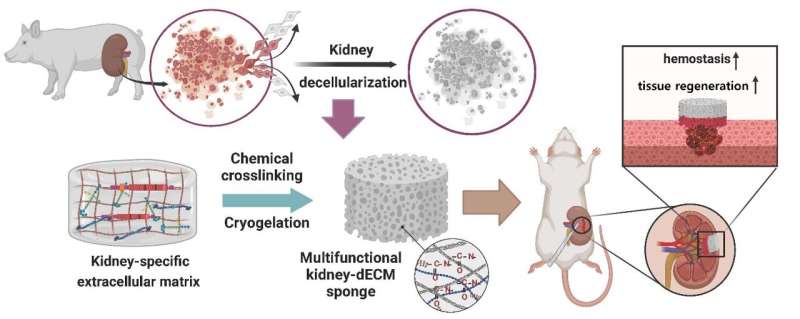This article has been reviewed according to Science X's editorial process and policies. Editors have highlighted the following attributes while ensuring the content's credibility:
fact-checked
peer-reviewed publication
trusted source
proofread
Research team develop porous sponge material for enhancing kidney hemostasis and repair

A POSTECH research team have crafted a material aimed at swiftly staunching kidney bleeding and facilitating wound recovery. Their research featured in the online edition of Biomaterials.
The kidneys play a crucial role in bodily functions including waste removal and blood pressure regulation. Despite being dubbed the silent organ due to its lack of overt symptoms, early detection of kidney tumors allows for their removal via partial nephrectomy. However, surgical complications such as excessive bleeding, infection, and tissue damage pose significant risks.
Patients undergoing such procedures are prone to developing chronic ailments such as diminished kidney function and hypertension, complicating both treatment and recovery processes.
In this research endeavor, the team including Professor Dong-Woo Cho from the Department of Mechanical Engineering along with Jae Yun Kim, a Ph.D. candidate, from the School of Interdisciplinary Bioscience and Bioengineering and others used kidney-derived decellularized extracellular matrix (dECM) to develop a hemostatic solution tailored for kidney applications.
The inherent presence of proteins and factors in dECM, mirroring those found in the body, facilitates the recreation of the kidney's distinctive microenvironment, thus boasting a notable level of biocompatibility. These attributes have propelled its widespread adoption in tissue engineering where it finds utility in the fabrication of artificial organs and the restoration of diverse tissue types.
Initially, the team scrutinized the composition of kidney-derived dECM to ascertain the presence of hemostatic elements within its structure. Subsequently, they mixed the kidney-derived dECM with a chemical cross-linker, successfully forming a porous sponge material termed "cryogel."
The team's gel exhibited a highly porous architecture, boasting an expansive surface area that efficiently absorbed blood. Animal studies revealed a significant reduction of tissue damage and necrosis by up to threefold four weeks post-partial nephrectomy when compared to both a control group and traditional gelatin sponges. Additionally, the team observed that the concentration of cross-linking agents in the renal gel affected crucial properties such as biodegradation rate and hemocompatibility.
Professor Dong-Woo Cho said, "This study underscores once more the clinical significance of dECM-based medical sponge materials."
More information: Jae Yun Kim et al, Degradation-controlled tissue extracellular sponge for rapid hemostasis and wound repair after kidney injury, Biomaterials (2024). DOI: 10.1016/j.biomaterials.2024.122524
Journal information: Biomaterials
Provided by Pohang University of Science and Technology





















